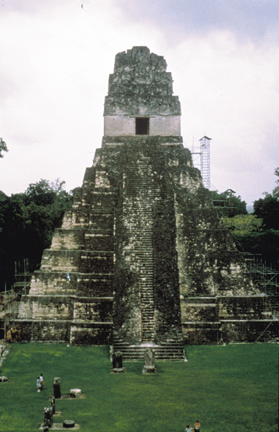 In February 1996,
paleoceanographer Larry Peterson of the University of Miami and colleagues on
the drillship JOIDES Resolution sunk a tube 170 meters long into the
Cariaco Basin off the coast of Venezuela. The tube took a core of finely laminated
sediments that had accumulated over 550,000 years, offering a rare glimpse into
annual changes in tropical climate through several glacial-interglacial cycles.
In February 1996,
paleoceanographer Larry Peterson of the University of Miami and colleagues on
the drillship JOIDES Resolution sunk a tube 170 meters long into the
Cariaco Basin off the coast of Venezuela. The tube took a core of finely laminated
sediments that had accumulated over 550,000 years, offering a rare glimpse into
annual changes in tropical climate through several glacial-interglacial cycles.A paper in the March 14 Science narrowed in on a 30-centimeter subsection of the core that spanned from 750 to 950 A.D., a time when the Classic Maya civilization collapsed. The Maya permanently abandoned urban areas, stopped constructing monuments, and returned to rural subsistence. A bimonthly record of precipitation preserved in the core indicates that a century-long dry period, punctuated by four major droughts, added strain to the disintegrating empire.
In summer and fall, the Intertropical Convergence Zone (ITCZ) sits right above the Cariaco Basin and the Yucatan Peninsula, seat of the Classic Maya civilization, bringing heavy rains. Surging rivers deposit sediment rich in titanium onto the basin floor. Titanium levels in the core serve as an index of precipitation; higher concentrations mean stronger rains. Anoxic bottom waters in Cariaco Basin prevent benthic fauna from disturbing these varved sediments, keeping the titanium record in remarkably pristine condition, Peterson says.
This limestone temple towers above other Maya ruins in Tikal, Guatemala — a testament to the thriving community that lived in the city from 600 to 800 A.D. When the Classic Maya civilization collapsed, the Maya permanently abandoned Tikal and other cities. Photo by David Hodell, University of Florida.
The research team used a technique called x-ray fluorescence to measure titanium concentrations in 50-micrometer segments along the core. While the x-ray method is not new, only in the past four years has the technology evolved enough to focus the x-ray beam on such small slices, says lead author Gerald Haug, a paleoclimatologist at the Swiss Federal Institute of Technology, Zurich.
Titanium concentrations fell sharply for several years around 760, 810, 860 and 910 A.D., marking times of multiyear droughts. Several years ago, Richardson Gill, an independent archaeologist from San Antonio, Texas, proposed that droughts drove the Mayans out of their cities in three distinct phases. Gill calculated times for the abandonments based on the last dates carved onto local monuments, and these times match precisely with the three later droughts recorded in the core.
“Our results clearly provide strong support for Gill’s hypothesis,” Haug says. However, the radiocarbon method used to date the droughts does have some wiggle room, says co-author and geochemist Daniel Sigman of Princeton University. Although counting varves gave precise durations for the intervals between droughts, the absolute dates for the droughts could be up to 30 years off, in either direction.
Anthropologist Brian Fagan of the University of California at Santa Barbara applauds the high-resolution data set, but points out that it does not cement a direct causal relationship between drought and city abandonment. Drought could have exacerbated other economic, social or environmental problems already fracturing the societies. For example, nobility often gained power by their relationship to the supernatural world and their ability to bring rains, Fagan says. Drought may have undermined their authority and the hierarchical society that stemmed from it.
In the mid-1990s, geochemist David Hodell at the University of Florida found evidence for ominously timed droughts in lake sediments from Lakes Chichancanab and Punta Laguna in the northern Yucatan Peninsula. However, Haug says, the Cariaco core offers more than 10 times the temporal resolution of those lake sediments. Also, critics have argued that deforestation around the lakes — not changes in precipitation — drove the observed changes in the lake sediments. In contrast, very few people lived in the Cariaco Basin watershed during the Maya collapse, limiting the deforestation concern for the new record.
Researchers plan to examine more sections of the Cariaco core at high resolution with two questions in mind, Sigman says: What caused the climate changes? How did those changes mix into the brew of society? “One of the questions is paleoclimatology, the other is archaeology. These fields are no longer separate domains.”
Greg Peterson

